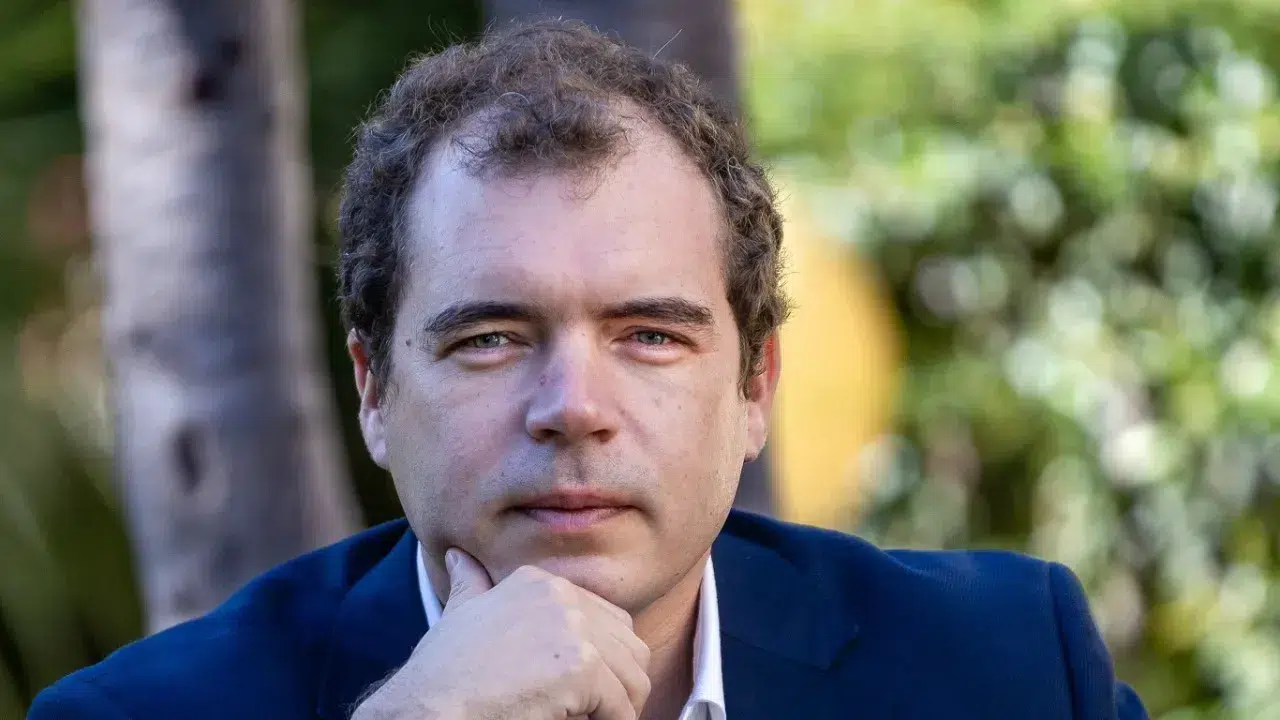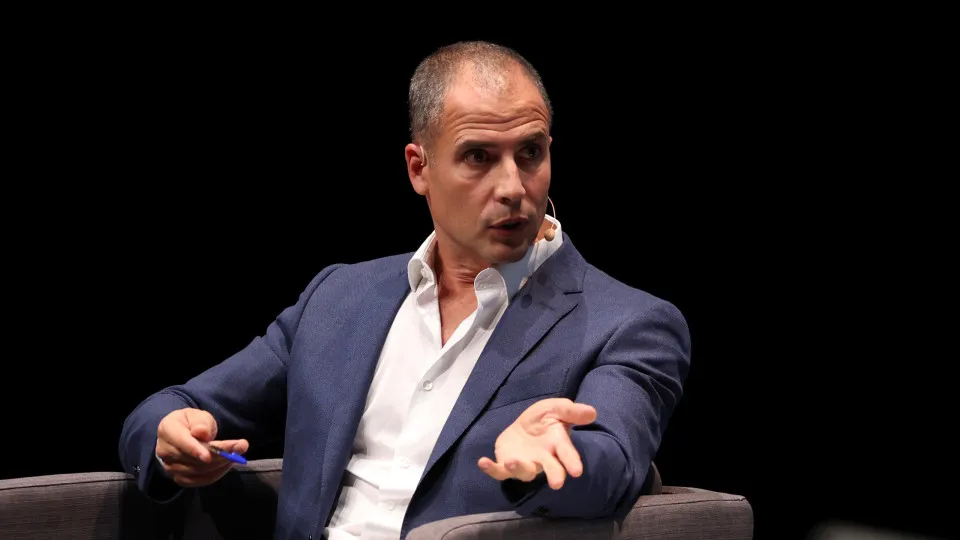
Published this week by Quetzal, ‘Morramos ao menos no porto’ is the second novel by Francisco Mota Soares — which was actually the first to be written — following ‘Aqui onde canto e ardo’, released last year by Gradiva and winner of the 2023 Agustina Bessa-Luís Revelation Award.
The story explores the relationship between Silvina and António, offering a depiction of a 25-year marriage told through various dimensions. It unveils a world filled with pain, death, and violence, underscored by a melancholic tone that even gives voice to the dead murmuring beneath the ground.
The title is inspired by Seneca, as revealed in an excerpt from ‘Letters to Lucilius’ presented at the book’s opening, which reads, “we live amidst the waves, let us at least die in port”.
In the midst of these waves live the characters of this novel, struggling to stay afloat, not always succeeding, and revealing the sordidness of which humans are capable, a theme that has always fascinated the author, as he confessed in an interview with Lusa.
“I’m very interested in constructing the violent sides of people, of characters, what our greatest pains are, and, in that sense, almost dissecting a specific character, going to the core and seeking where our greatest violence lies. In that sense, [the novel] becomes ruthless,” he stated.
The writer Adriana Lisboa, a member of the José Saramago Prize jury, commented at the time of the award that this novel is “ruthless” and that readers are not seeking pity, nor do they want to be pampered. Francisco Mota Saraiva agrees with this classification, as he has always sought the darker side of humanity, even as a reader.
“By nature, I seek a certain darkness in reading, even in art. I think that, in some way, when I write — I wish I had a talent for painting, but I don’t — often, in what I write, it’s almost like wanting to create certain paintings,” he said.
Francisco de Goya is an example he refers to when discussing his “very dark paintings,” which, while not necessarily serving as direct inspiration, possess “a darker and gloomier side” that interests him greatly.
António narrates the story, soothing the sadness of being a widower while tending to his wife Silvina’s wounds, a deceased body sitting in a rocking chair, with her odors mingling in the city’s sewers, hidden by the scent of flowers.
Other characters include a midwife who performs abortions for young girls, a sergeant who believes he’s a colonel and chases boys in the park, a smuggler who takes boys on illegal crossings over the border, corrupt ministers, a road accident, and a boy in motion who remains in the same place.
Almost all events unfold in the same building, with its creaky old wooden floor, holes in the walls, and odors emanating from the drains.
Francisco Mota Saraiva explains that he conceptualized a city in his mind without concern for location or timeframe, but through his observations of the world.
“I’m not very interested in telling an exact story because everything has already been written and told, but I’m interested in exploring the human condition’s pains, difficulties, and greatest challenges, such as prostitution, pedophilia, and there’s always a place for hypocrisy, where politics is very present.”
For the writer, writing from the observation of space is “an inevitability”.
“There are no stories that are absolutely captivating or that make us think and delve deep into ourselves without seeking that more violent and profound sense,” he considered, explaining the themes that come to him.
However, he clarifies that this was never his initial goal, “it naturally evolved, to compose the people who frequent and move in that city, with all those anxieties and social issues.”
The building where much of the action occurs takes on a life of its own and served as the starting point, “a small detail” that gained dimension.
“When I started writing the book, I lived in one of those old houses with high ceilings and wooden floors. These houses have a lot of history and life, they have the sound of creaking wood, and it feels like the house moves on its own. That’s when I started to imagine what it would be like if someone were beneath that floor, as if they were our dead beneath the same floor, speaking.”
He then constructed the story in the image of the building where he lived, with a diverse array of people and characters observing one another.
Francisco Mota Saraiva’s narrative style challenges the foundations of classic storytelling, presenting itself as a torrent of writing, interweaving words and images almost without interruption, giving the reading a constant and continuous rhythm, while simultaneously being musical, blending raw and poetic language.
Like any art or craft, this writing demands work and refinement, but at its core lies the influence of jazz, a musical style he greatly enjoys.
“Jazz is full of various instruments that seem to sometimes interrupt each other. Yet, a melody persists. What I do, often when writing, is also read aloud what I write, trying to find that music without losing control of the direction I want to go, as if there’s a kind of score, and I’m writing in those interstices,” he explained.
Certain words recur throughout the text, used for different characters and situations, almost like a linking thread, a linguistic device the writer uses as a kind of “refrain of the music”.
“I have a very obsessive side within me, and those recurring words help me complete certain circles, calling me back to the character’s construction. Obviously, not intentional, but I think this can function as a certain guide for the reader within the text,” he remarked.
A jurist and consultant by profession, holding a degree in Law and a master’s in Law and Management, Francisco Mota Saraiva cannot explain how he became a novelist but has been writing since early on. He vividly recalls the moment he found his voice: at 14, during a school composition about the holidays.
“I decided to write something a bit different, more fictional, perhaps more untruthful, and from there, I thought I could do different things,” he recalled, adding that since then, he has continued to write and, after finishing university, began dedicating himself more rigorously and disciplinedly, especially in the mornings and weekends.
Today, he juggles both tasks because he needs to earn a living and has bills to pay: “I approach this as someone who needs two professions to survive. On one side is a profession, let’s say, more mechanical, more repetitive, and on the other is what I actually enjoy, which is writing.”
With two published novels, he has won awards twice, an uncommon achievement that admittedly causes him some anxiety, but not to the point of fearing writing and being unable to meet the expectations created or surpass his previous works.
“There are no expectations to maintain. I know my way of writing, it’s the way I know how to write, and it enabled me to be published. If I can continue to write this way and keep refining my writing, if I can be honest with what I write, I think that’s already halfway accomplished,” he stated.
The launch event for ‘Morramos ao menos no porto’ will take place on March 27, at 18:00, in the José Saramago room at the Biblioteca Palácio Galveias in Lisbon.








